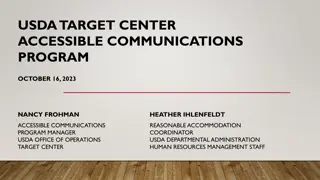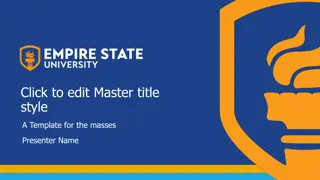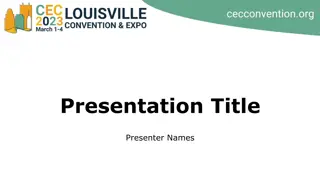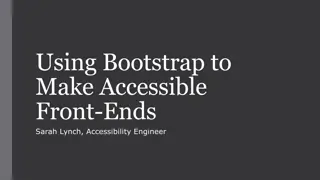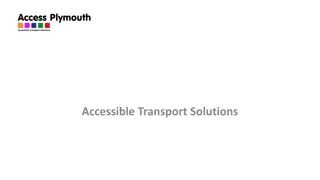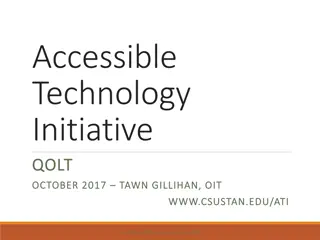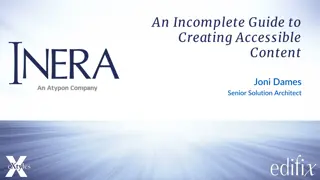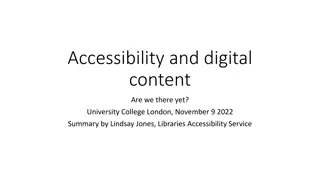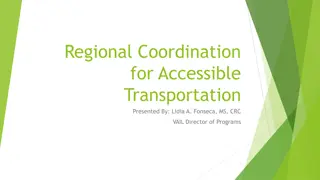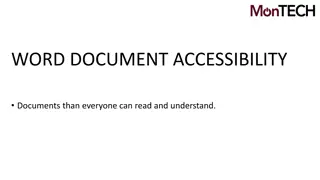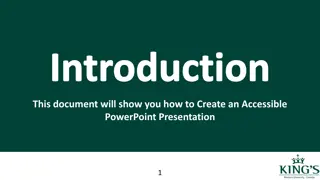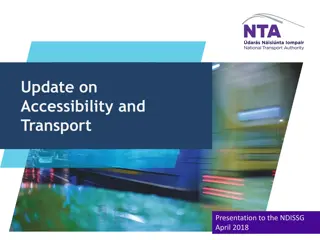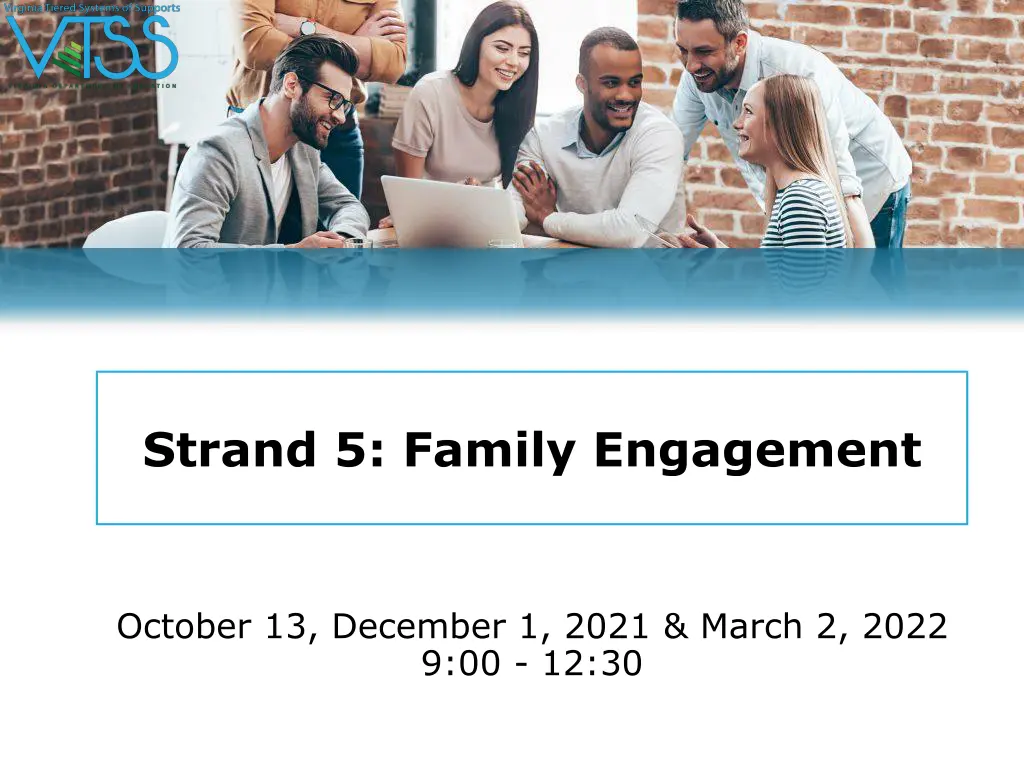
Exploring Essential Elements of Family Engagement in Multi-Tiered Systems
Delve into the intricacies of meaningful family engagement within multi-tiered systems to enhance collaborative partnerships between families and schools. Learn strategies to empower families, collect and share data, and develop visions for equitable collaboration.
Download Presentation

Please find below an Image/Link to download the presentation.
The content on the website is provided AS IS for your information and personal use only. It may not be sold, licensed, or shared on other websites without obtaining consent from the author. If you encounter any issues during the download, it is possible that the publisher has removed the file from their server.
You are allowed to download the files provided on this website for personal or commercial use, subject to the condition that they are used lawfully. All files are the property of their respective owners.
The content on the website is provided AS IS for your information and personal use only. It may not be sold, licensed, or shared on other websites without obtaining consent from the author.
E N D
Presentation Transcript
Strand 5: Family Engagement October 13, December 1, 2021 & March 2, 2022 9:00 - 12:30
Virtual Norms Expectations What does that look like? Be Engaged Unmute to share ideas/questions. Participate in virtual activities. Be Respectful Eliminate distractions like cell phones, email, social media, and background noise. Give others time to talk and share. Be committed to attend the full session. Be Prepared Download materials prior to the session. Set dates/times with your team to continue action planning after professional learning.
Navigating ZOOM! CHAT MUTE YOUR MICROPHONE HIDE YOUR VIDEO CAMERA
Checklist Download the VTSS Strand 5 Family Engagement Oct. 2021 Workbook at https://vtss-ric.org/ Record your Attendance
Strand 5 In this strand, participants will explore six essential elements of meaningful family engagement in multi-tiered systems of supports that deepen family and school commitment to collaborative and equitable partnerships while increasing specific student and family outcomes across domains.
What is the first thought that comes to mind? What is the most underused resource in education today? Parents. - Lauren Tripp Barlis, Relationships That Make a Difference
What we will learn and do. Given the current diversity of virtual and in-person learning approaches related to the pandemic response, we understand the nature of family engagement has changed and is constantly evolving. Understand the value of, and strategies for, collecting and sharing key data on family collaboration. Recognize the critical importance of empowering all families as partners in decision making. Begin to develop or refine a vision for family and community engagement. Action plan toward equitable family and community collaboration to improve student well-being and academic success, while recognizing the ongoing pandemic stress experienced by students, families and educators.
The VTSS Framework 1.Aligned Organizational Structure 2.Data Informed Decision Making 3.Evidence-Based Practices 4.Family, School, and Community Partnerships 5.Monitoring Student Progress 6.Evaluation
What does this look like? Please see your VTSS State Coach for this diagram.
Family Engagement in VTSS ...an active, interactive, dynamic, and ongoing process in which family members and key stakeholders engage as equal partners in decision-making, planning, and implementation to support children and adolescents across settings . Aligning and Integrating Family Engagement in PBIS
Breakout Rooms See page 5 in the Workbook. Identify one statement that aligns with your view of family engagement. Then, discuss as a team - what common values are you noticing among your team members? Identify a reporter to share when we return.
Family Engagement Components Positive Relationships - Educators recognize families needs and cultural characteristics, leading to greater understand and respect among all. Family Empowerment - Educators use effective strategies to identify and encourage families knowledge, skills and efficacy for supporting students learning. From Minch et al., 2017
Family Engagement Components (cont.) Leadership - Family Engagement is included in professional development, school vision, mission, and goals and are aligned with division vision and goals for engagement. Multi-tiered, Multi-Dimensional Approach - Multidimensional approaches are used to engage families in dialogue through multiple communication modes. Use of different approaches to engage families whose children are at different tiers.
Six Components (cont.) Data-based Goals & Outcomes - Goals and outcomes are based on student outcomes as well as family data; input from families and staff is sought and used. Collaborative Problem-Solving - Families of children receiving Tier 2 and Tier 3 supports are effectively engaged in all steps of the problem-solving process.
VTSS Implementation Matrix Please see your Workbook or VTSS State Coach for this information.
Family Engagement, PBIS, CR- PBIS and MTSS Alignments Please see your VTSS State Coach for this diagram. Minch, Kincaid, Tremaine & Thomas, (2017) Aligning & Integrating Family Engagement in PBIS
Family Engagement in VTSS Videos Please see the Formed Families Forward website for this video. https://formedfamiliesforward.org / resource_category/family- engagement
Promoting Equity in Education Through Family Engagement Please see the Formed Families Forward website for this video. https://formedfamiliesforward.org/ resource_category/family-engagement/
Which component(s) does your division do well? Multi-tiered, Multi- Dimensional Approach Data-based Goals & Outcomes Collaborative Problem-Solving Positive Relationships Family Empowerment Leadership Discuss Division Strength(s) Is it consistent across schools? What facilitates these strengths? What assets are already in place? How do you know an element is a strength? Workbook pg. 6
Why Engage Family, Youth, and Community For students: higher math and reading achievement higher social skills adapt better to school and attend more regularly lower aggressive behaviors Research base for parent engagement - American Institutes for Research https://www.youtube.com/watch?v=jt_EyDney-4
Engagement for Families perception of their job description shifts gain confidence in their ability to share and influence their children s learning and development develop an increased sense of accountability to their school or neighborhood, and advocate for all children versus their children empower to take on new challenges in terms of their educations and careers link their personal growth with civic and political action Mapp, K., Carver, I. and Lander, J., 2017
Engagement for Educators In elementary schools, teacher perceptions of parents as partners in students education are strongly related to their decisions to remain in their school. Increased trustful relationships with families. Increased communication with families. Increased teacher longevity. Mapp, K., Carver, I. and Lander, J., 2017
National Federation of Families 2021 Survey 49% reported school was going worse than expected. Balancing school and work time was most challenging for families, followed by meeting special education needs, navigating platforms and support from teachers and schools. Both caregivers and their children are experiencing an increase in behavioral health symptoms (anxiety, depression, substance use, negative thoughts; ~70%).
Pandemic Stressors The pandemic has: placed children and families at increased risk for traumatic stress and loss (NCTSN, 2021) exacerbated the realities of long standing disparities in academic opportunities for many students of color (OCR, June 2021)
Attendance Connections 71% of recent dropouts believe the most effective way to have kept them and to keep their peers in school is through increased communication with families and increasing parent involvement. (Gates Foundation study, 2006)
Breakouts Think about the pandemic stressors and attendance connections and discuss. Please be plan to share afterwards.
Realities of this year. What education do students receive when they are quarantined? Is virtual learning being provided? Do students/families have internet access? How are we communicating with families so they understand? What other barriers have families experienced?
Families: Our Most Valuable Resource Please see your VTSS State Coach for this diagram. From Devon Minch, 2019
What do educators want from family engagement? visit the school and attend school events cooperation with school requests and expectations (especially regarding homework) home-based support to establish value of school and teachers ability respond to written communications from schools (signatures)
What do families want from family engagement? to feel heard and listened to more opportunities for open, ongoing, two-way communication discussions, not assumptions, especially as it pertains to: parenting and academic/behavioral concerns families lack of attendance at school events opportunities to define their engagement opportunities to advocate for the best interest of their children less social isolation from other families in the building
Breaking the Cycle Ideas, objectives, initiatives, and strategies that require a shift in thinking will drift toward the existing culture unless significant work is done to augment, expand, and change the culture to embrace the desired change.
Strengthening the School-Family Partnership Education Now: Strengthening the School-Family Partnership in a Pandemic The shutdowns this spring forced schools and families into crisis mode as they tried to keep students learning while also keeping them healthy and safe. The joint effort to guide students through the crisis revealed the depth and importance of the school and family partnership. As the new school year begins, educators and education leaders must reevaluate what family engagement looks like in the era of COVID-19. How can schools maintain connections with families during an unpredictable year when physical presence is not guaranteed? Join us for Strengthening the School-Family Partnership in a Pandemic, when we ll bring together Karen Mapp, an internationally known innovator in the field; Sarah Friedman, a Central Falls, RI, school leader; and Svati Mariam Lelyveld, a middle school teacher in New York City. Together, they ll offer insights on how to build an equity-based, justice-focused, and pandemic-tested family engagement strategy as this unprecedented year begins. The conversation will be hosted by Richard Weissbourd, co-director of HGSE's Human Development and Psychology program and director of HGSE s Making Caring Common project. *** Education Now is an HGSE webinar series that responds to the dramatic changes in the field of education in the wake of the Covid-19 pandemic. Each 30-minute episode is designed to prompt observations and insights that are thought-provoking and actionable. In addition to Zoom, Education Now webinars are streamed to YouTube, Facebook, and other social platforms, as well as to the HGSE website, at hgse.me/ednow. This episode concludes our summer series, The Challenges of Reopening. Visit hgse.me/ednow to view past episodes and for our fall schedule. -- Harvard Graduate School of Education Website: http://www.gse.harvard.edu Follow us on Instagram: https://www.instagram.com/harvardeducation/ Like us on Facebook: https://www.facebook.com/HarvardEducation/ Follow us on Twitter: https://twitter.com/hgse Since its founding in 1920, the Harvard Graduate School of Education has been training leaders to transform education in the United States and around the globe. Today, our faculty, students, and alumni are studying and solving the most critical challenges facing education: student assessment, the achievement gap, urban education, and teacher shortages, to name just a few. Our work is shaping how people teach, learn, and lead in schools and colleges as well as in after-school programs, high-tech companies, and international organizations. The HGSE community is pushing the frontiers of education, and the effects of our entrepreneurship are improving the world.
Team Time - Data and Practices 1. Do you currently collect ongoing family feedback, and have you noticed any evolving challenges? 1. What community partnerships have you discovered are critical as the instructional model has shifted from face to face instruction to remote and hybrid models? 1. What communication and engagement protocols, practices and strategies have worked well, and what changes and improvements are possible? Workbook pg. 10 Revised, based on VDOE Recover, Redesign, Restart document
Creating a Vision for Family Engagement Your informed vision for family engagement (educator/ family collaboration) is key. Engagement has these aspects: behavioral (things we can observe); emotional (interest, value, and feelings toward the school environment); and cognitive (effort; building new thinking/ skills)
Managing Complex Change Please see your Workbook or VTSS State Coach for this diagram.
Confusion Please see your Workbook or VTSS State Coach for this diagram.
Begin Your Vision A vision statement is an idealized description of a desired outcome that energizes, inspires and helps you create a mental image of your target. Remember engagement may have behavioral, emotional and cognitive aspects.
Creating a Vision for Family Engagement Take a few minutes for each team member to think individually and then respond to the following: If we could create the division of our dreams, what would family engagement look like and sound like? What words, colors or images capture the heart of your vision? Take turns sharing your words, phrases and images. What are the common themes and threads? Workbook pg. 10
Expanding the Vision How will you seek input from families and the community to inform your vision? What additional data or information might you want to gather to have a clearer picture of your current reality? Team task: by the December session, develop a vision statement for family engagement in your division. Is there a visual image that inspires your team? Workbook pg. 11
Break Give yourself a chance to take a Break from work. You deserve to feel refreshed. Jesse Neo
Moving to Action Using the worksheet in the workbook, consider how each component of family engagement aligns with your draft vision. Complete columns 2 & 3. Positive Relationships Empowering Families Leadership Data based Goals and Outcomes Multi-dimensional, Multi-tiered Approaches Collaborative Problem Solving Workbook pgs. 13 - 15 - Columns 2 &3
Reflections Which component did your team find easiest to complete? Why? What areas of actions, skills, resources and motivators does your team feel are most in place , ready to roll? What areas of actions, skills, resources and motivators does your team see as the greatest need or farthest reach? What data is available now? Are those data at division or school or other level? How confident are you in those findings? Do those data need to be updated?
Digging Deeper With Data What can we use to collect information about engagement from stakeholders? Beginning of the Year Questionnaire for Families Michigan Family Engagement Strategy Checklist Family Engagement Self Assessment from Madison WI Metro School District (MMSD) Create your own! Workbook pgs. 13 - 15 - Column 4
High-impact Family Engagement What are you already doing? Please see your Workbook or VTSS State Coach for this diagram.
How do you currently engage families throughout the Tiered Model? Please see your Workbook or VTSS State Coach for this diagram.
Return to the Data Worksheet Using the information from your multi- tiered triangle, return to the Vision to Data worksheet and consider under which components your family engagement activities fall. Then list the data sources from right side of triangle to your Vision to Data worksheet. Note where you may need more information!
For December 1.Develop a vision statement with input from families, community partners and others in your division. 2.Identify tiered family engagement supports and data sources. 3.View and then share the Family Engagement in VTSS video series with other division leaders and school teams to help them understand the 6 components. 4.Consider next steps for collecting family and community data. Return in December ready to share your vision and completed worksheets.
Take-a-ways Triangle/Square/Circle using Padlet


